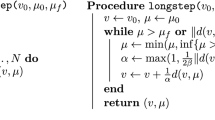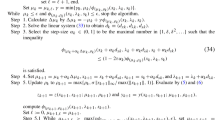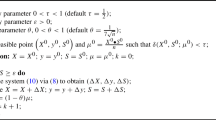Abstract
We describe a primal-dual interior point algorithm for convex quadratic programming problems which requires a total of\(O\left( {\sqrt n L} \right)\) number of iterations, whereL is the input size. Each iteration updates a penalty parameter and finds an approximate Newton direction associated with the Karush-Kuhn-Tucker system of equations which characterizes a solution of the logarithmic barrier function problem. The algorithm is based on the path following idea. The total number of arithmetic operations is shown to be of the order of O(n 3 L).
Similar content being viewed by others
References
C.C. Gonzaga, “An algorithm for solving linear programming problems in O(n 3 L) operations,” Memorandum Number UCB/ERL M87/10, Electronics Research Laboratory, University of California (Berkeley, CA, March, 1987).
S. Kappor and P.M. Vaidya, “Fast algorithms for convex quadratic programming and multicommodity flows,” in:Proceedings of the 18th Annual ACM Symposium on Theory of Computing (Berkeley, California, May 1986) pp. 147–159.
N. Karmarkar, “A new polynomial time algorithm for linear programming,”Combinatorica 4 (1984) 373–395.
M. Kojima, S. Mizuno and A. Yoshise, “A polynomial-time algorithm for a class of linear complemtarity problems,”Mathematical Programming 44 (1989) 1–26, this issue.
M.K. Kozlov, S.P. Tarasov and L.G. Khachiyan, “Polynomial solvability of convex quadratic programming,”Doklady Akademiia Nauk SSSR 5 (1979) 1051–1053. [Translated in:Soviet Mathematics Doklady 20 (1979) 1108–1111.]
C.E. Lemke, “On complementary pivot theory,” in: G.B. Dantzig and A.F. Vienott, eds.,Mathematics of the Decision Sciences, Part I (American Mathematical Society, Providence, RI, 1968) pp. 95–114.
N. Megiddo, “Pathways to the optimal set in linear programming,” Research Report, IBM Almaden Research Center (San Jose, CA, 1986).
C.R. Papadimitriou and K. Steiglitz,Combinatorial Optimization: Algorithms and Complexity (Prentice-Hall, Englewood Cliffs, New Jersey, 1982).
P.M. Vaidya, “An algorithm for linear programming which requires O(((m + n)n 2+(m + n) 1.5 n)L) arithmetic operations,” Preprint, AT&T Bell Laboratories (Murray Hill, NJ, 1987).
Y. Ye and E. Tse, “A polynomial algorithm for convex quadratic programming,” Working Paper, Department of Engineering-Economic Systems, Stanford University (Stanford, CA, 1986).
Author information
Authors and Affiliations
Rights and permissions
About this article
Cite this article
Monteiro, R.D.C., Adler, I. Interior path following primal-dual algorithms. part II: Convex quadratic programming. Mathematical Programming 44, 43–66 (1989). https://doi.org/10.1007/BF01587076
Received:
Revised:
Issue Date:
DOI: https://doi.org/10.1007/BF01587076




